One Pakistani woman’s battle to marry of her own free will
In 1996, a court case between a father and daughter would ask: Could Pakistani women choose their own husbands?
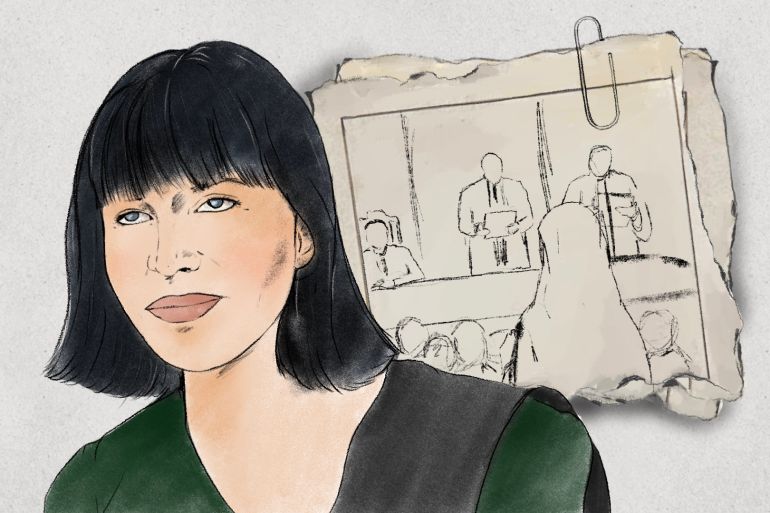
It was the spring of 1996 and the newspapers were filled with love stories. Runaway girls. Budding romances that “started with a cup of ice cream”. The story of the young woman who “eloped with her college van driver”. The cautionary tales of girls who ended up in shelters because they had “run away from their homes with their boyfriends who later abandoned them”.
In a courtroom in Lahore, one love story sat for judgement.
Keep reading
list of 4 itemsTen years after Chibok girls kidnapping: One woman’s struggle to move on
Poland lawmakers take steps towards liberalising abortion laws
Arizona’s top court allows near-total 1864 abortion ban to go into effect
At the front: a bench of three judges. Before them, the lawyers, including Asma Jehangir, one of Pakistan’s foremost human rights activists and the woman who, in 1980, founded the first female-led law firm in the country. Behind them, a bespectacled man with a full dark beard and a velveteen karakul cap on his head. Spectators filled the benches: women’s rights activists, reporters, the legal fraternity, and men in green or black turbans that signified their support for religious parties. There was scarcely any space in the room. The lawyers who usually made room for the elderly or women now elbowed them or glared if they were asked to move.
And at the back: a police guard at her side, a seated, young, hijab-wearing woman of 22. The turbaned men were there to support her father, the bearded man at the front, who had taken his daughter and her husband to court for marrying without his permission. On the days of the hearings, the men filled the parking lot of the Lahore High Court, hissing and shouting at Jehangir as her car arrived. On Mall Road outside, there were banners and posters calling for Jehangir’s death, branding her a heretic. A group of religious leaders led a procession carrying an effigy of Jehangir and buried it. The sermon at Friday prayers in some mosques warned against her. The men lined the path from the parking lot to the courtroom, chanting slogans – “Naara-e-takbir Allah hu Akbar!” (God is Great!) – and stared down Jehangir’s associates as they walked through the corridors. There were armed police on the court roof. In April, one of the turbaned men had been arrested for bringing a pistol to court. After that, these men made sure that Jehangir and her associates – young women who had just gotten their licences, interns, researchers, 20-something-year-old lawyers – could see them reach into the pocket of their kameez as though they were reaching for a gun, a knife, anything that could hurt them. They wanted them to imagine what they could do.
The father saw all this. He would have known of the pistol. He would have seen the banners and the police that accompanied his daughter to court and stayed by her side. He would have watched as one of the judges began the proceedings by addressing his daughter in the back of the courtroom.
“Saima!” one of the three judges called out. “You have disgraced your family. You have disgraced your culture.”
This judge often did this.
Saima would stand. One of the lawyers remembers how she was strikingly tall. Another, how she could be in a group of women and stand out. How she had these piercing blue eyes. The women remember her soft, beautiful features, full lips. She took care to groom herself, her eyebrows in neat arches. She enjoyed doing her makeup – “getting dolled up for court”, as one woman remembered it. “Loving the limelight”. Those blue eyes: she wore coloured lenses. “In court, half the press corps were in love with her,” Jehangir told a foreign journalist at the time.
Saima would look at the judge.
“You’re a disgrace,” he would repeat.
The women in court would watch, waiting for her reply.
Saima would draw a breath, and open her mouth to shout back at him.
‘Kill them all, kill all the lovers’
Karachi, 1996. Nazish Brohi was a lowly intern at a monthly news magazine when she got a break: A senior reporter asked if she would like to work on the story of Saima Waheed with her as the case continued in Lahore.
I asked Nazish what she remembers of that time. How did people speak about Saima? What did they make of her? Nazish’s memories of that time, 27 years ago, have faded, but there is one conversation she has not forgotten: One day at a roadside flower market, Nazish chatted with the “phool waala” (flower seller), and asked what he made of it all – Saima, the man she fell in love with, the father’s court case against the couple.
“Sure, kill them all, kill all the lovers,” he said sarcastically. He grumbled. “The only people who buy my flowers are those who visit graves and the people in love. And they want to kill these lovers.”
In the papers at the time: “Saima, the love-story heroine”
“A young woman’s rebellion.”
“Saima says there’s no going back.”
“Saint or Sinner?”
“It is ‘Romeo and Juliet’ and ‘King Lear’ rolled into one.”
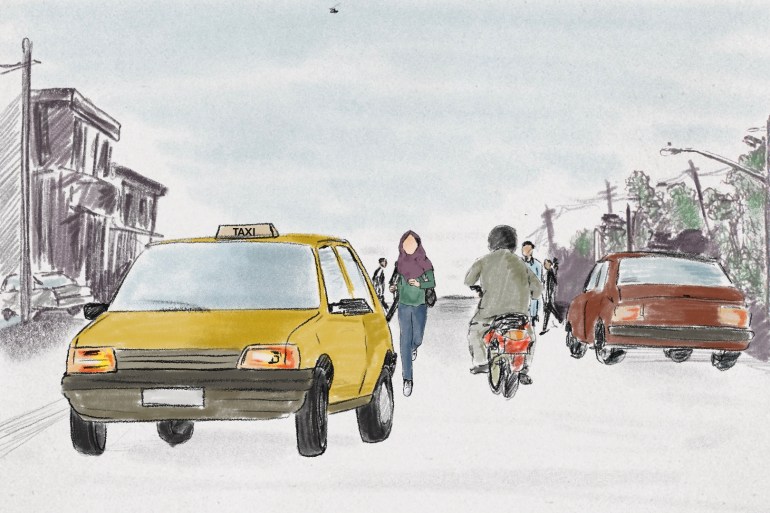
‘I won’t like any other boy’
Saima Waheed was 20, still in college finishing an MBA when she met 27-year-old Arshad Ahmed. He visited her family home in Lahore’s affluent Model Town neighbourhood twice a week as an English literature tutor for Saima’s brother. Although Saima would see Arshad visiting the house, she did not meet or speak with him there.
Saima was head girl at Lahore College for Women and a member of the debating team. She was coddled by her father, Abdul Waheed Ropri: She was given 10,000 rupees (today $35.50) a month as pocket money and for work she did at his company, which produced pipelines. She had a mobile phone, credit cards, and a car and driver at her disposal. The Ropris were well-off. Saima and her siblings reportedly had televisions in each bedroom. Satellite television, by now beamed into millions of Pakistani households, aired American soaps such as, The Bold and the Beautiful. She watched dramas on PTV, the national broadcaster, and was inspired, she told a journalist later, by “several ideas to make excuses to meet Arshad”.
Arshad was a lecturer at Pattoki Government College, making 5,000 rupees ($17.75) a month. Arshad’s father, who owned a ball-bearing shop, had reportedly known Ropri more than a decade ago when they worked in the same market in Lahore.
Saima and Arshad crossed paths at a debate competition and began to chat on the phone. By the time Saima turned 21, Arshad proposed marriage. His parents visited Saima’s home to request her hand, and were promptly refused. Ropri had other plans for Saima. At 14, she had been promised to her cousin, but refused to wear his ring. The engagement was dissolved and her father then accepted a new proposal from a doctor. “I knew his family were very devout people,” Saima said in an interview with The Times UK newspaper. She met the doctor “once, at our engagement celebration,” she told the reporter. “He was 41.” In another interview with the South China Morning Post, Saima said she phoned the doctor and pleaded with him to withdraw his proposal as she liked someone else. “He said, ‘Every girl is like you before her marriage. You’ll get a diamond ring. Everything will be fine.’”
“I am not a goat or a sheep to be sold off to the highest bidder,” Saima told another journalist.
In February 1996, Saima lied to her parents about needing to collect some certificates from college and met Arshad at a lawyer’s office where they signed a “nikkah” (marriage contract), solemnising their marriage.
A little more than a week later, Saima informed her parents about the marriage. “[My father] hit me hard across my face,” she said in an interview. “He had never hit me before.”
A doctor was summoned and he gave her a sedative that left her unconscious. She was locked in her room and not given food for three days. Her telephone line was cut, her mobile phone, car keys and money were taken away. When her father threatened to still marry her to the doctor, she told him, “You can take me to the wedding but I won’t sign the marriage certificate. You can cut off my hands first.”
Saima tried to bargain. “I said to him, ‘If you don’t like Arshad, don’t marry me to anyone else,’” she recounted in an interview. “I won’t like any other boy. I’ll carry on with my studies. I’ll continue to help you in the business. I’ll lead this life and not marry anyone.”
A month later, in April, the door to her room was accidentally left unlocked. Saima fled, climbing the Ropri home’s boundary wall and hailing a taxi. She had never been in a taxi before.
She had seen Asma Jehangir’s name in the newspapers or on a poster outside her college. When Saima was later asked in interviews about that day, she often changed her answer. She might have stopped at the lawyer’s office where she had married Arshad and they told her to go to AGHS, Asma’s law firm. This is where she found herself in April 1996, climbing two flights of stairs above a bank to an office with an unmarked plywood door.
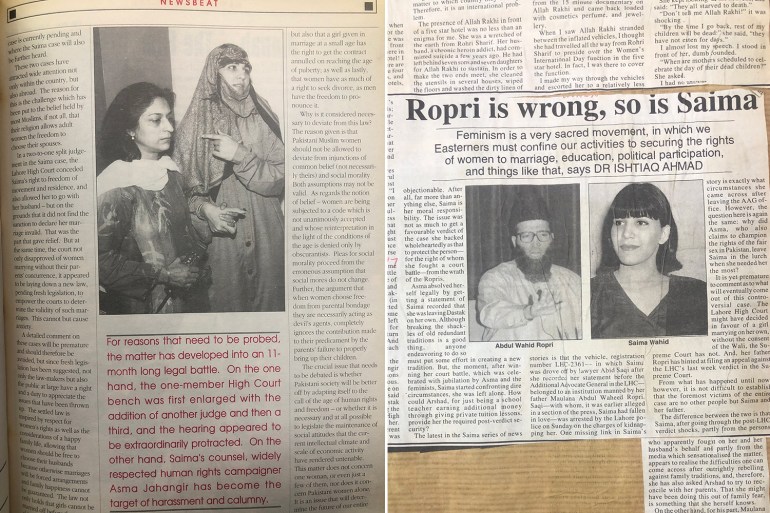
‘Girls all over the country are on the run’
“Reading the newspapers these days gives a strange impression,” an op-ed in local daily The News noted in the autumn of 1996. “It seems suddenly girls all over the country are on the run; that they are running away from their homes; that there is a danger of society falling apart because of this … that we are at the brink of some kind of social chaos.”
The women’s stories jostled for space in the papers. Fathers, brothers, mothers and sisters unhappy with the choice a woman had made to marry the man she loved turned to the courts and police for help. The easiest thing to do was to claim that the woman’s husband was actually illegally confining her, that she was helpless and had been forced into this “free will marriage”.
There was the one in which a woman was “recovered” from a village by a court bailiff as her sister filed a habeas corpus petition alleging that she was being held against her will.
The one in which two Christian sisters, Veronica and Salonica, married two constables and converted to Islam. Their father claimed they were kidnapped. The two girls, now Sana and Mahak, appeared at the Lahore High Court to confirm they were not under any pressure and did not want to live with their parents.
The one in which Humaira Khokhar, daughter of a feudal and political family, told her parents she loved someone and they locked her in the home. When she tried to escape, they admitted her to a hospital and had her legs, arms, head and neck wrapped in a cast so she was unable to leave for two months. After suicide attempts, a forced wedding, and a raid by the family on a shelter where Humaira sought refuge, the couple managed to flee to the airport where they were nabbed by six men and Punjab police just as they were about to check in. When the deputy speaker of the Punjab Assembly was asked about the violence against the couple, he brushed it aside: “These are very common lies of people who have committed wrongs against a family.”
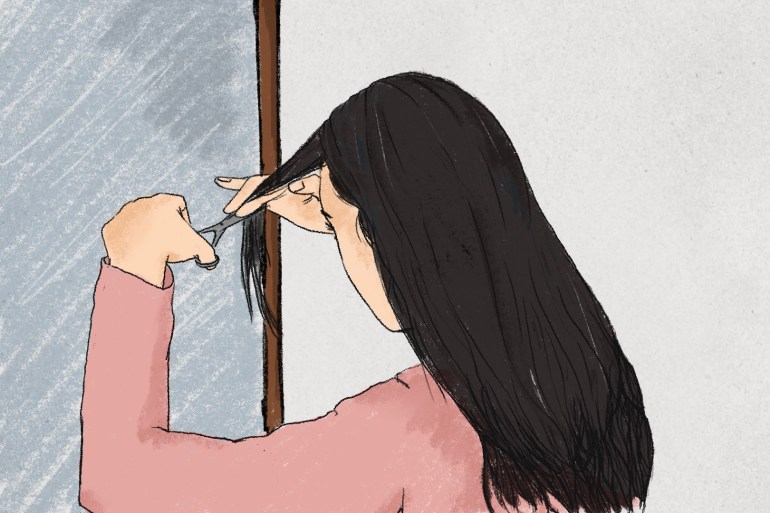
‘Sell their own women like sheep’
In 1996, Robina Shaheen had been in charge at the Dastak women’s shelter, started by Asma Jehangir’s sister, the lawyer Hina Jilani, for three years – enough time to change some habits. When someone stared at Robina, then 25 years old, on the street, she did not wonder if they found the shade of her lipstick fetching or her beautiful. She felt fear that they recognised her and would hurt her. She wore a burka to conceal herself. When the office car picked her up, she would lie on the back seat so she was not seen. The car often dropped her in a market where she already knew which shops looked deceptively small in front but led to a warren of lanes at the back.
The shelter’s name, “Dastak”, means “a knock at the door”. The shelter’s location was not disclosed to the public but it was found out and there were ceaseless threats. Angry husbands said they would blow it up. “A woman comes to Dastak when she has burned all her bridges,” Robina said. Women had escaped forced marriages, violence, murder attempts, or sexual assault. There were eight rooms with three to four beds in them. Some of the women had children with them. Many were educated professionals and the shelter did not restrict them from going to work.
In April 1996, when Robina met Saima, she felt the girl was confident despite her fear. Often women would sit before Robina and their hands would tremble as they tried to speak, or they would spread their empty hands before Robina as if to ask, ‘What should I do? I have nothing.’ Some clasped their hands tightly, unable to talk. Saima told Robina that she had fled her home and was scared for her life.
Less than two weeks after Saima’s arrival at Dastak, her father petitioned the courts to declare her marriage void as she did not seek his permission for it. “The arguments being advanced by Saima’s parents … basically revolved around certain sayings of the Holy Prophet, the rights of parents as enshrined in the Holy Quran, social customs and the risk of our turning into a permissive society if the restraining influence of parents on their daughters was removed,” the daily Dawn noted.
Saima spent her days at Dastak reading the papers – once she was awake, that is. Unable to sleep at night, she would sleep in. She read how she was being reported on and she gave interviews over the phone. She was friendly with the staff and they cooked her something she called “gaaj maaj”, a mix of vegetables.
One day, she was at the AGHS office when the men in her family walked in. Her father had successfully petitioned the court to move Saima to a government-run women’s shelter, where he would have greater access to her. He claimed his daughter was under an “evil” influence at Dastak. Ropri was accompanied by a court bailiff and police. When Saima refused to leave, scared that her father had no intention of taking her to a shelter, but would instead forcibly take her home, he grabbed her by the hair and tried to drag her out and into a waiting car. Saima clung to furniture, tugged between her family and the AGHS lawyers who tried to hold her. The police intervened and took Saima to a station to wait for her lawyer.
In court, Jehangir argued that Saima, an adult, had the right to choose where she sought shelter. Saima told the judge she did not want to go to a government shelter or her parent’s home. “The character of every male in my family leaves a lot to be desired,” the newspapers reported her saying in court. “They ogle each and every woman within eyesight, sell their own women like sheep and generally indulge in every vice imaginable. But if a woman of their family wants to live her own life, they turn it into a religious issue.”
After five days at a government shelter, the judge permitted her to return to Dastak.
Back at Dastak, Saima sat in on classes or sessions, and in one beautician training class, she cut off her long hair.
‘What can a woman own then, if not even herself?’
In September 1996, about six months after Abdul Waheed Ropri petitioned the courts to invalidate his daughter’s marriage, Justice Abdul Hafeez Cheema passed a verdict on two other cases that would subsequently raise alarm about Saima’s case.
Justice Cheema declared two marriages void as the girls had married without their “wali’s” – male guardian’s – consent. One of the parents’ lawyers argued that, “in an Islamic society, if every girl was allowed to run away, many girls would end up falling victim to clever persons.”
In his judgement, Justice Cheema held TV shows responsible for a decline in moral values: “After the introduction of dish antennae and… [TV stations] not merely containing obscenity but clearly targeting to destroy the Islamic concept of life, one cannot close one’s eyes over the increasing cases of abduction, rape and secret courtships.” He claimed the country was witnessing a “tornado of sexual rebellion”.
A dangerous precedent was set with this verdict. The girls could now be prosecuted under the Hudood Ordinances.
In February 1979, on the day Muslims around the world were celebrating the Prophet Muhammad’s birth, military ruler Zia ul-Haq announced the ordinances as part of his aggressive campaign to “Islamise” Pakistan. Under the new “zina” (adultery, fornication) laws, sex outside marriage was a criminal offence. Punishments ranged from lashes to stoning or incarceration. Rape was now defined as intercourse between two persons who were not married or sex with consent that had been granted based on the incorrect belief that the two persons are married.
“All across Pakistan, women who have married without the consent of their parents or wali … feel they now have cause to be worried,” one newspaper reported. In another, a columnist asked, “Islam says a woman cannot give herself in marriage without the consent of her guardian. What can a woman own then, if not even herself?” Journalist Farah Zia, who had married of her own choice, remembers that she had not even heard this word, “wali”, before these court cases.
The country had a female prime minister, Benazir Bhutto. “A woman cannot exercise her will independently in as personal a matter as her own marriage,” wrote Zohra Yusuf, an activist and journalist. “She can, however, take decisions (if she happens to be the head of the government) that affect the entire nation, including, presumably, the judiciary.”
Meanwhile, women belonging to six religious organisations held a demonstration outside the Lahore High Court in support of Justice Cheema’s verdict. “They said millions of Pakistani women had praised the court verdict which, they regretted, had been criticised by some westernised women,” the daily Dawn reported.
By January 1997, a survey by the magazine, Herald, asked respondents, “Would you allow your daughter to marry of her own free will?” Sixty-six percent of men and women answered, “No.”
“Are love marriages better than arranged marriages?” Eighty-seven percent said, “No.”
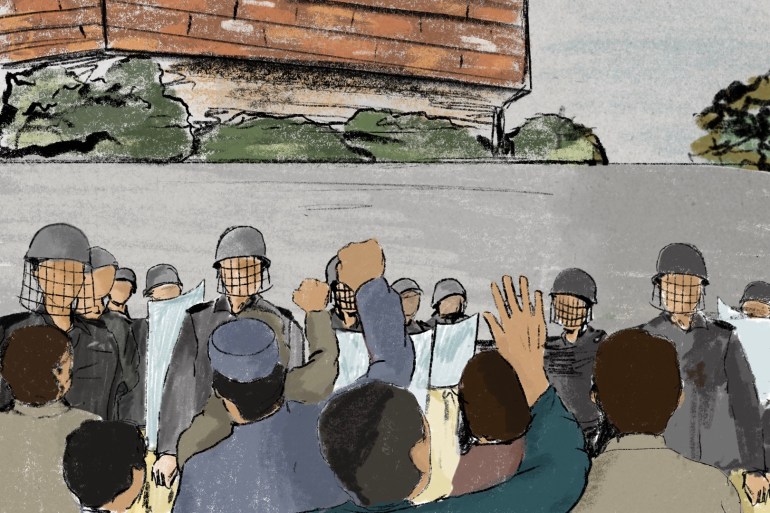
The protesters would have made mincemeat of us all
In court, Saima’s father’s lawyers pointed to her new short bob cut and Saima’s jeans under her abaya as proof that Dastak changed women, encouraged them to be rebellious. But Saima was wearing jeans the day she came to the shelter, Robina recalled. At the AGHS office, when Saima had spotted Asma Jehangir’s daughter Munizae, she was surprised that the girl was wearing shalwar kameez. It seemed so conservative, Saima implied. Munizae, then 15, asked her mother if she was unfashionable.
As the hearings into her case continued, Saima spent time at Dastak writing in her diary. She wrote poetry. She found community among the women at the shelter. On the days she returned from court hearings, she was upset. She cried as she told Robina how she was her father’s favourite. There had only been one other instance of rebellion in their family, when one of her father’s cousins married against the family’s wishes and fled to the US. When this cousin’s husband travelled to Pakistan three years later, he was shot dead.
Saima’s father’s supporters had grown. His case drew the attention of ultra-conservative scholars and religious groups who saw it as a litmus test. “We support the father because we fear that a judgement in the girl’s favour in such a publicised case would encourage other girls to desert their parents and elope with their lovers,” said one of Ropri’s supporters at a court hearing.
One day, the student wing of a religious party threatened to attack Dastak. Women’s rights activists and their supporters rushed to the shelter. The media reports they got as they waited were both frightening and exaggerated: 1,000 men were coming to the shelter with sticks. The police arrived and stood between the shelter and its supporters and the men, who pelted the shelter with stones. The women inside hid from the stones smashing into the courtyard. Neelam Hussain, a women’s rights activist, knew that the shelter’s supporters would not be able to do much – but it was important, she remembered thinking at the time, that the women inside knew that there were people willing to stand between them and the stones. If the police were not there, the protesters would have made mincemeat of us all, she recalled.
Not one woman at Dastak turned against Saima and asked for her to be sent elsewhere, as her presence brought risk to them all. Not one woman chose to leave the shelter after it was attacked.
Saima lived at Dastak for 11 months.
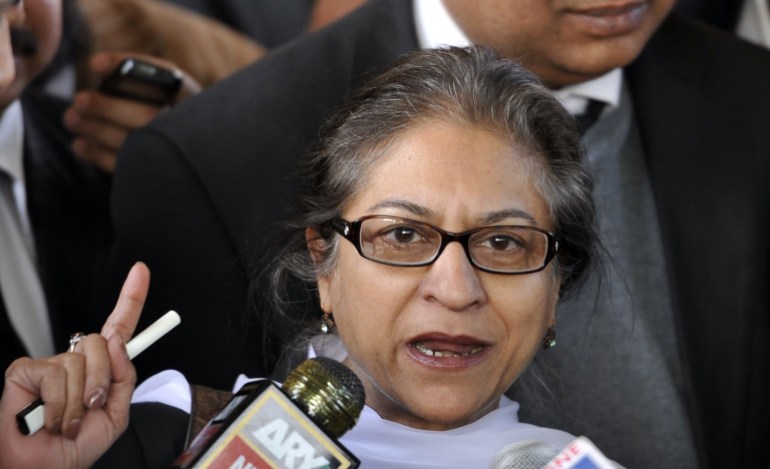
‘Saima mutilated every Islamic and family tradition’
At the time of the hearings, rage against Asma Jehangir had been simmering for a few months. In 1995, she filed an appeal in a case in which an 11-year-old Christian boy, Salamat Masih, despite being illiterate, had been found guilty of writing blasphemous words on the wall of a mosque along with two other men. One of the men had been shot and killed outside the courtroom. Jehangir won the case and the child was acquitted. There were stickers and posters across the city calling Jehangir a “blasphemer”. She received letters and phone calls threatening her with death. Sometimes, she told her munshi (clerk) about the threats when she had to be in court the following day, and he made sure to wrap up her cases quickly and get her out of there.
Armed men broke into her family home and beat her brother and his wife. Vicious rumours spread: Jehangir was not a Muslim; she made “blue films”; Dastak was a brothel; Jehangir was a “Western agent”, a pawn who received money to work against Pakistan. Photographs of her teenage daughters were printed in the newspaper and Jehangir sent them out of the country to the UK for their safety.
Nida Aly joined AGHS at the end of 1996. Her family was happy she was working at the law firm. Some acquaintances made snide comments. Asma is a bad influence, they said. There was a nickname for her: talaako maasi. The one who gets couples divorced.
Abdul Waheed Ropri said his daughter had been “indoctrinated” by Jehangir. “Saima mutilated every Islamic and family tradition,” he told a reporter, and Jehangir was goading her on.
By 1997, one of the judges who acquitted Salamat Masih was shot dead in his chambers in the Lahore High Court.
![[Courtesy: Sanam Maher]](/wp-content/uploads/2023/03/s4.jpg?w=770&resize=770%2C513)
‘The first drop of rain’
In March 1997, two out of three judges upheld the validity of Saima and Arshad’s marriage, ruling that a Muslim adult woman can choose who she marries without seeking her guardian’s consent.
At Dastak, they celebrated with sweets, and Saima waited to meet Arshad for the first time in months. He had been arrested in May 1996, accused of forging the marriage certificate, and when he was released, a judge ordered that the couple should not meet until their case was closed. Saima felt, she said to reporters, “like the first drop of rain”.
“I feel as if I am reborn.” She and Arshad said they wanted to write a book about their ordeal.
“We got by with the skin of our teeth,” said Asma Jehangir. “Women may have won the battle, but the war is not yet won.” The verdict was no full-throated support for women. Justice Malik Muhammad Qayyum’s judgement validated the marriage as “despite [his] best efforts”, he had not been able to discover a principle on which to argue that an independent, adult Muslim woman could not marry of her own will. He added that “run-away marriages are abhorrent and against the norms of our society”.
Justice Khalilur Rehman Ramday, while also finding in Saima’s favour, expressed the need for legislation to make “immoral relationships and secret marriages a penal offence”. He was scornful of the idea of women choosing their husbands. “Husband-shopping”, he called it. “The females should ordinarily stay indoors… if it becomes inevitable for her to talk to a man… she should [do so] from behind a screen or a veil.”
Justice Ihsanul Haq Chaudhry gave the dissenting judgement. If women begin to marry without their wali’s consent, he said, “Marriage will lose all its sanctity and the witnesses, lawyers would all be hired/arranged … as is happening in Reno, Nevada.”
Abdul Waheed Ropri said that if suicide was not a sin in Islam, he would have killed himself because of the humiliation he suffered at his daughter’s hands. He pledged to appeal the decision in the Supreme Court. In 2003, the Court gave a verdict against him once more. By then, his daughter and Arshad were living in Norway.
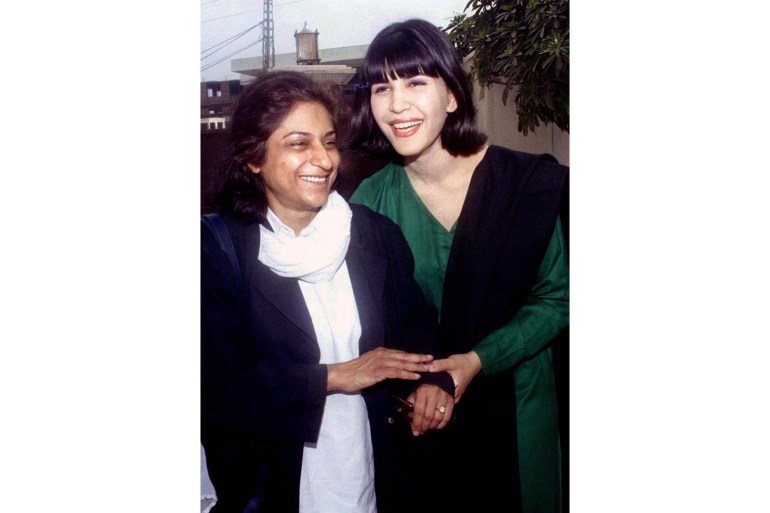
Was it worth it?
This March marks 27 years since the case. Asma Jehangir passed away in 2018. Not one person I spoke with knows of Saima’s whereabouts today. Robina remembers her last conversation with Saima. It was sometime during the court case. She was at the AGHS office, very excited to speak with Jehangir about something. “She had this habit of wagging her finger at you when she was making a point,” Robina said. “She told me, ‘Just watch, I’ll win this fight. I’m telling the truth. What I’m doing is right, isn’t it?’ She would say that to me a number of times.” In one photo taken at court, Saima tightly grasps Jehangir’s hand. Her other hand gestures towards Jehangir, finger outstretched, caught mid-sentence perhaps. Those at AGHS and Dastak never heard from Saima after March 1997, not even a note or message of condolence when Jehangir died. They feel she does not want to be found. They ask me if I have tracked her down. I tell them that I stopped looking. That at some point, I did not know why I would disturb her. What would I have wanted to know?
The first question, naturally, for many people, is, “Are Saima and Arshad still together?” That question is important only if this article is regarded as a love story.
They want to know, “Was it worth it?”
“Do you know how many women would have turned up at shelters like Dastak after this case because they had heard of Saima? Because they remembered her?” Robina tells me.
Many women today do not recognise Saima’s name. Nida, the lawyer at AGHS, was not surprised. “The first time that most women see a nikkahnama (marriage certificate) is on the day they get married,” she explains. They do not know about the woman who fought against the notion that she needed permission to marry of her own free will. “We don’t know of our rights when it comes to something as personal and important as our marriages. If you know Saima Waheed’s name today, it’s sheer luck. You would never have been taught about her. It’s just not part of the history we feel young women should know.”
Which part of this story will you remember? I return to the moment Saima realised the door to her room had been left unlocked and she fled her home, not knowing what would become of her. Was it worth it?
Activist Neelam Hussain had watched in court as Ropri went up against Ropri, each surprising the other by refusing to back down. “Saima’s father had gotten her an education, he wanted her to be trendy, he saw her as a good object for the marriage mart,” Hussain said. “He stood her before the window of the wide world on display. He could not understand why she wanted to jump out.”